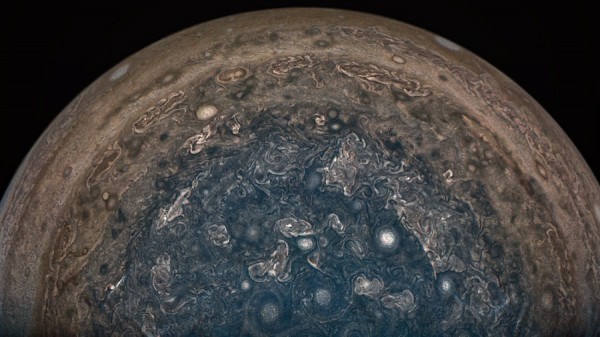By Ana Verayo, | February 20, 2017

NASA's Juno spacecraft soared directly over Jupiter's south pole when JunoCam acquired this image on February 2, 2017 at 6:06 a.m. PT (9:06 a.m. ET), from an altitude of about 62,800 miles (101,000 kilometers) above the cloud tops.
NASA just announced that Jupiter probe Juno will not be able to enter into a closer orbit of the gas giant, considering this maneuver as too risky. Last October, there were already two helium check valves that prevented Juno from getting closer to orbit.
NASA's Juno spacecraft arrived at Jupiter in July 2016 and has already completed four 53 day orbits around the biggest planet in the solar system. Juno also beamed back high resolution imagery and data back to mission control on Earth despite the gas giant's powerful magnetic fields and aurora that might make it difficult for the probe to send back precious data.
Like Us on Facebook
The initial plan was to conduct an engine burn to bring Juno closer for a 14 day orbit in order to take a peek inside the thick, swirling cloud cover of Jupiter. Now, the probe will remain in its wider orbit and carry out the rest of its observations.
According to Juno mission project manager Rick Nybakken of NASA's Jet Propulsion Laboratory, after reviewing this intensively, we placed Juno at multiple scenarios during a short period orbit however, there was still a concern regarding another main engine burn that can prove undesirable results. Simply put, a burn poses a risk to completing Juno's science objectives.
Despite this major setback, NASA says that the mission will now result in "bonus science" as Juno will observe the outer layers of Jupiter's magnetosphere and sift through its solar winds, which is a new part of the mission. Mission scientists also add that Juno will also not suffer anymore from the powerful radiation belts of Jupiter that can apparently destroy scientific equipment.
According to Thomas Zurbuchen of NASA's Science Mission Directorate, Juno is in healthy condition where its science instruments are fully operational. The data and imagery we have received are spectacular. However, the decision to not proceed with this crucial engine burn to get closer to Jupiter is the right thing to do, to preserve Juno so that it can continue to discover more of Jupiter.
To date, the tiny probe is in its 53 day orbit, some 2,600 miles on top of Jupiter's fierce, swirling clouds. Juno will continue this orbit until July 2018 completing another full 12 orbits. Its next close flyby will be in March 27 when it enters an elliptical polar orbit.
-
Use of Coronavirus Pandemic Drones Raises Privacy Concerns: Drones Spread Fear, Local Officials Say

-
Coronavirus Hampers The Delivery Of Lockheed Martin F-35 Stealth Fighters For 2020

-
Instagram Speeds Up Plans to Add Account Memorialization Feature Due to COVID-19 Deaths

-
NASA: Perseverance Plans to Bring 'Mars Rock' to Earth in 2031

-
600 Dead And 3,000 In The Hospital as Iranians Believed Drinking High-Concentrations of Alcohol Can Cure The Coronavirus

-
600 Dead And 3,000 In The Hospital as Iranians Believed Drinking High-Concentrations of Alcohol Can Cure The Coronavirus

-
COVID-19: Doctors, Nurses Use Virtual Reality to Learn New Skills in Treating Coronavirus Patients







